
David Glasgow Farragut was a flag officer of the United States Navy during the American Civil War. He was the first rear admiral, vice admiral, and admiral in the United States Navy. He is remembered for his order at the Battle of Mobile Bay, usually paraphrased as "Damn the torpedoes, full speed ahead" in U.S. Navy tradition.

David Porter was an officer in the United States Navy in the rank of captain and the honorary title of commodore. Porter commanded a number of U.S. naval ships. He saw service in the First Barbary War, the War of 1812 and in the West Indies. On July 2, 1812, Porter hoisted the banner "Free trade and sailors' rights" as captain of USS Essex. The phrase resonated with many Americans. Porter was later court martialed; he resigned and then joined and became commander-in-chief of the Mexican Navy. Porter County, Indiana was named after him.

The third USS Hornet was a brig-rigged sloop-of-war in the United States Navy. During the War of 1812, she was the first U.S. Navy ship to capture a British privateer.
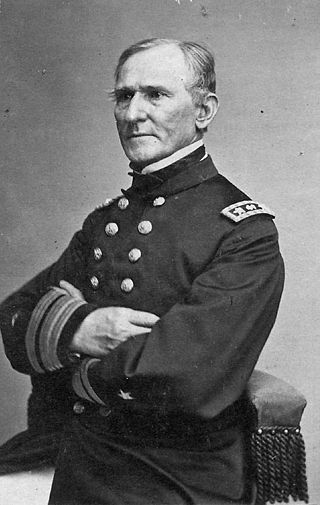
Henry Haywood Bell was an American admiral in the United States Navy. In the American Civil War, he took part in the liberation of New Orleans and the lower Mississippi. Later he was sent to the Far East to command the East India Squadron. In summer 1867, he led a punitive expedition to avenge the Rover incident, in which he ultimately drowned.

The first John Adams was originally built in 1799 as a frigate for the United States Navy, converted to a corvette in 1809, and later converted back to a frigate in 1830. Named for American Founding Father and president John Adams, she fought in the Quasi-War, the First and Second Barbary Wars, the War of 1812, the Mexican–American War and the American Civil War. At the end of her career, she participated in the Union blockade of South Carolina's ports. She then participated in the raid on Combahee Ferry that Harriet Tubman, the former slave and Union operative, organized with Union colonel Montgomery. John Adams led three steam-powered gunboats up the Harbor River to Port Royal. The squadron relied on local black mariners to guide it past mines and fortifications. The squadron freed 750+ slaves and unsettled the Confederacy. Tubman was the first woman in U.S. history to plan and execute an armed expedition.
Commodore John Thomas Newton was an officer in the United States Navy who commanded several ships over a period of decades, undertaking missions in the Caribbean and leading the first crossing of the Atlantic by an American steam-powered warship. He was court-martialed following a fire that destroyed that vessel, but his suspension from service was remitted by President John Tyler, after which Newton commanded Pensacola Navy Yard and the Home Squadron for periods. He died while serving in his last post as president of a Naval Court of Inquiry.

The term Mosquito Fleet has had a variety of naval and commercial uses around the world.

David Dixon Porter was a United States Navy admiral and a member of one of the most distinguished families in the history of the U.S. Navy. Promoted as the second U.S. Navy officer ever to attain the rank of admiral, after his adoptive brother David G. Farragut, Porter helped improve the Navy as the Superintendent of the U.S. Naval Academy after significant service in the American Civil War.
Diabolito or Little Devil was a 19th-century Cuban pirate. One of the more violent of the era, he engaged the United States Navy and Revenue Marine Service several times. Being one of the main fugitives hunted and pursued later by American Naval forces during the West Indies anti-piracy operations of the United States in the Caribbean during the 1820s. He was also known for having a mixed-race crew, which included “English, Frenchmen, Spaniards, Mulattoes, and Negroes.”
USS Spitfire was the former Baltimore privateer Grampus that the United States Navy purchased. She was a heavily armed schooner built for service in the War of 1812, but did not see service until the Barbary Wars when she was sent with the American fleet to the Mediterranean to force an end to piracy of American ships.
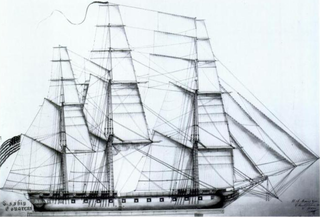
The West Indies Squadron, or the West Indies Station, was a United States Navy squadron that operated in the West Indies in the early nineteenth century. It was formed due to the need to suppress piracy in the Caribbean Sea, the Antilles and the Gulf of Mexico region of the Atlantic Ocean. This unit later engaged in the Second Seminole War until being combined with the Home Squadron in 1842. From 1822 to 1826 the squadron was based out of Saint Thomas Island until the Pensacola Naval Yard was constructed.

The New Orleans Squadron or the New Orleans Station was a United States Navy squadron raised out of the growing threat the United Kingdom posed to Louisiana during the War of 1812. The first squadron consisted of over a dozen vessels and was mostly defeated during the war. Afterward, new ships were stationed at New Orleans which engaged in counter-piracy operations for over twenty years. The New Orleans Squadron was eventually merged with the Home Squadron.
The first USS Greyhound was a U.S. Navy, two-masted schooner in commission from 1822 to 1824.
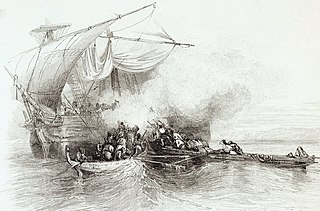
Aegean Sea anti-piracy operations began in 1825 when the United States government dispatched a squadron of ships to suppress Greek piracy in the Aegean Sea. The Greek civil wars of 1824–1825 and the decline of the Hellenic Navy made the Aegean quickly become a haven for pirates who sometimes doubled as privateers.
The first USS Terrier was a United States Navy schooner in commission from 1823 to 1825. It was part of the West Indies squadron and served transporting U.S. sailors, marines and supplies to the pirate infested waters of the Caribbean and was used to search out and attack pirate ships and pirate strongholds.
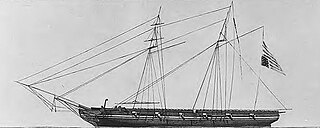
The West Indies Anti-Piracy Operations refer to the United States Navy presence in the Antilles, and surrounding waters, which fought against pirates. Between 1814 and 1825, the American West Indies Squadron constantly pursued pirates on sea and land, primarily around Cuba and Puerto Rico.After the capture of Roberto Cofresi in 1825, acts of piracy became rare, and the operation was considered a success, although limited occurrences went on until slightly after the start of the 20th century.

The USS Firefly, was a brig with two masts, square-rigged, formerly named Volant and originally built as a schooner for use as a privateer. The U.S. Navy purchased Volant on 8 December 1814 at New York by and was fitted her out as US naval 14-gun brig. She served during the War of 1812 and Second Barbary War of 1815. Firefly was purchased because of the several US blockade efforts where smaller ships with better maneuverability were needed for the task. The Navy sold her in 1816 and she became a Portuguese slave ship.

USS Wildcat was a two masted schooner of 48 tons and was part of a U.S. naval fleet, and part of the West Indies Squadron, that sailed to the Caribbean to subdue the occurrence of pirate raids on merchant ships that had increased to almost 3,000 by the early 1820s. She was armed with three guns and had a crew of 31. Wildcat was commanded by Lieutenant Legare' who sailed her to Washington with a dispatch regarding the disposition of the squadron and other matters concerning the war against piracy in the Caribbean. On 28 October 1824 Wildcat was lost in a gale with all hands while sailing between Cuba and Thompson's Island, West Indies. Approximately 31 drowned.
The USS Weasel was a three-gun schooner in the United States Navy.
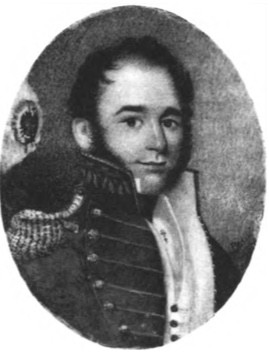
Thomas Jefferson Leib was an American naval officer of the early 19th-century sailing ship era, active in Florida's Second Seminole War as well as anti-piracy and smuggling suppression patrols throughout the Gulf of Mexico, Caribbean Sea, and West Indies.














